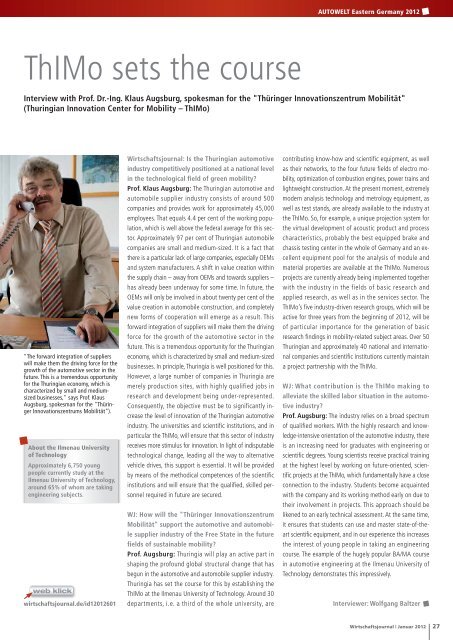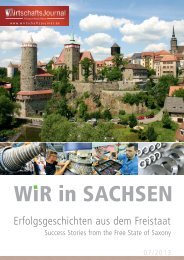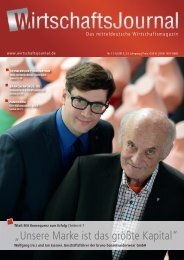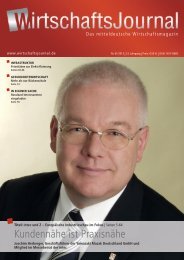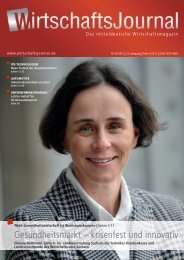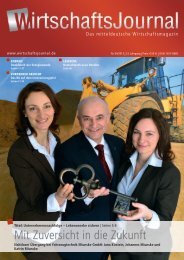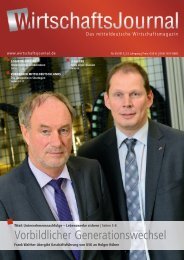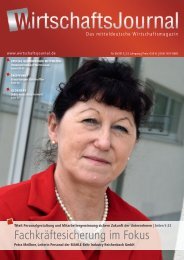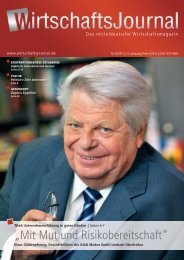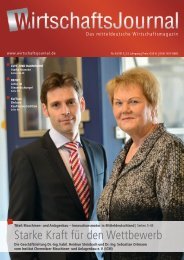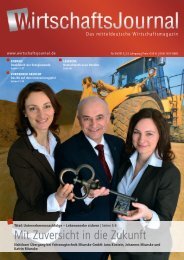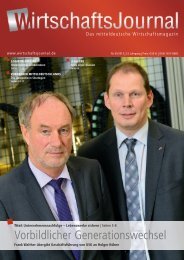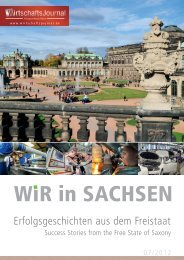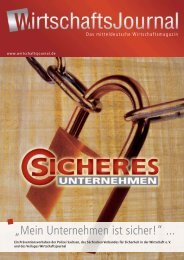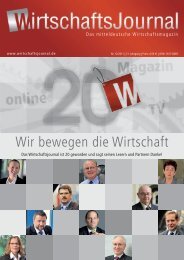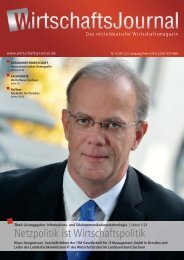„Die Zeichen stehen auf Forschung und ... - Wirtschaftsjournal
„Die Zeichen stehen auf Forschung und ... - Wirtschaftsjournal
„Die Zeichen stehen auf Forschung und ... - Wirtschaftsjournal
Erfolgreiche ePaper selbst erstellen
Machen Sie aus Ihren PDF Publikationen ein blätterbares Flipbook mit unserer einzigartigen Google optimierten e-Paper Software.
ThIMo sets the course<br />
AUTOWELT Eastern Germany 2012<br />
Interview with Prof. Dr.-Ing. Klaus Augsburg, spokesman for the "Thüringer Innovationszentrum Mobilität"<br />
(Thuringian Innovation Center for Mobility – ThIMo)<br />
"The forward integration of suppliers<br />
will make them the driving force for the<br />
growth of the automotive sector in the<br />
future. This is a tremendous opportunity<br />
for the Thuringian economy, which is<br />
characterized by small and mediumsized<br />
businesses," says Prof. Klaus<br />
Augsburg, spokesman for the "Thüringer<br />
Innovationszentrums Mobilität").<br />
About the Ilmenau University<br />
of Technology<br />
Approximately 6,750 young<br />
people currently study at the<br />
Ilmenau University of Technology,<br />
aro<strong>und</strong> 65% of whom are taking<br />
engineering subjects.<br />
wirtschaftsjournal.de/id12012601<br />
<strong>Wirtschaftsjournal</strong>: Is the Thuringian automotive<br />
industry competitively positioned at a national level<br />
in the technological field of green mobility?<br />
Prof. Klaus Augsburg: The Thuringian automotive and<br />
automobile supplier industry consists of aro<strong>und</strong> 500<br />
companies and provides work for approximately 45,000<br />
em ployees. That equals 4.4 per cent of the working population,<br />
which is well above the federal average for this sector.<br />
Approximately 97 per cent of Thuringian automobile<br />
companies are small and medium-sized. It is a fact that<br />
there is a particular lack of large companies, especially OEMs<br />
and system manufacturers. A shift in value creation within<br />
the supply chain – away from OEMs and towards suppliers –<br />
has already been <strong>und</strong>erway for some time. In future, the<br />
OEMs will only be involved in about twenty per cent of the<br />
value creation in automobile construction, and completely<br />
new forms of cooperation will emerge as a result. This<br />
forward integration of suppliers will make them the driving<br />
force for the growth of the automotive sector in the<br />
future. This is a tremendous opportunity for the Thuringian<br />
economy, which is characterized by small and medium-sized<br />
businesses. In principle, Thuringia is well positioned for this.<br />
However, a large number of companies in Thuringia are<br />
merely production sites, with highly qualified jobs in<br />
research and development being <strong>und</strong>er-represented.<br />
Consequently, the objective must be to significantly in -<br />
crease the level of innovation of the Thuringian automotive<br />
industry. The universities and scientific institutions, and in<br />
particular the ThIMo, will ensure that this sector of industry<br />
receives more stimulus for innovation. In light of indis putable<br />
technological change, leading all the way to alternative<br />
vehicle drives, this support is essential. It will be provided<br />
by means of the methodical competences of the scientific<br />
institutions and will ensure that the qualified, skilled personnel<br />
required in future are secured.<br />
WJ: How will the "Thüringer Innovationszentrum<br />
Mobilität" support the automotive and automobile<br />
supplier industry of the Free State in the future<br />
fields of sustainable mobility?<br />
Prof. Augsburg: Thuringia will play an active part in<br />
shaping the profo<strong>und</strong> global structural change that has<br />
begun in the automotive and automobile supplier industry.<br />
Thuringia has set the course for this by establishing the<br />
ThIMo at the Ilmenau University of Technology. Aro<strong>und</strong> 30<br />
departments, i.e. a third of the whole university, are<br />
contributing know-how and scientific equipment, as well<br />
as their networks, to the four future fields of electro mo -<br />
bility, optimization of combustion engines, power trains and<br />
lightweight construction. At the present moment, extremely<br />
modern analysis technology and metrology equipment, as<br />
well as test stands, are already available to the industry at<br />
the ThIMo. So, for example, a unique projection system for<br />
the virtual development of acoustic product and process<br />
characteristics, probably the best equipped brake and<br />
chassis testing center in the whole of Germany and an ex -<br />
cellent equipment pool for the analysis of module and<br />
material properties are available at the ThIMo. Numerous<br />
projects are currently already being implemented together<br />
with the industry in the fields of basic research and<br />
applied research, as well as in the services sector. The<br />
ThIMo’s five industry-driven research groups, which will be<br />
active for three years from the beginning of 2012, will be<br />
of particular importance for the generation of basic<br />
research findings in mobility-related subject areas. Over 50<br />
Thuringian and approximately 40 national and international<br />
companies and scientific institutions currently maintain<br />
a project partnership with the ThIMo.<br />
WJ: What contribution is the ThIMo making to<br />
alleviate the skilled labor situation in the automotive<br />
industry?<br />
Prof. Augsburg: The industry relies on a broad spectrum<br />
of qualified workers. With the highly research and knowledge-intensive<br />
orientation of the automotive industry, there<br />
is an increasing need for graduates with engineering or<br />
scientific degrees. Young scientists receive practical training<br />
at the highest level by working on future-oriented, scien -<br />
tific projects at the ThIMo, which f<strong>und</strong>amentally have a close<br />
connection to the industry. Students become acquainted<br />
with the company and its working method early on due to<br />
their involvement in projects. This approach should be<br />
likened to an early technical assessment. At the same time,<br />
it ensures that students can use and master state-of-theart<br />
scientific equipment, and in our experience this in creases<br />
the interest of young people in taking an engineering<br />
course. The example of the hugely popular BA/MA course<br />
in automotive engineering at the Ilmenau University of<br />
Technology demonstrates this impressively.<br />
Interviewer: Wolfgang Baltzer<br />
<strong>Wirtschaftsjournal</strong> | Januar 2012<br />
27


